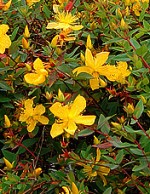 Common St. John’s wort is a herbaceous perennial known for its medicinal properties from ancient times. It is native to Europe, western Asian and North Africa but was introduced to the US in the eighteenth century and is now found from Minnesota south to central Texas, east to the Atlantic Coast, and west to the northern Pacific coast. Plants occur in a wide variety of habitats including pastures, meadows, rangelands, woodlands, open forests, natural clearing, moist ravines, abandoned fields, roadsides, and ditches. Common St. John’s wort contains a chemical that irritates the mouth of livestock and is therefore a special problem in grazing land.
Common St. John’s wort is a herbaceous perennial known for its medicinal properties from ancient times. It is native to Europe, western Asian and North Africa but was introduced to the US in the eighteenth century and is now found from Minnesota south to central Texas, east to the Atlantic Coast, and west to the northern Pacific coast. Plants occur in a wide variety of habitats including pastures, meadows, rangelands, woodlands, open forests, natural clearing, moist ravines, abandoned fields, roadsides, and ditches. Common St. John’s wort contains a chemical that irritates the mouth of livestock and is therefore a special problem in grazing land.
Description: The root system of St. John’s wort consists of one or many aerial crowns attached to a system of vertical and lateral roots. The vertical roots reach a depth of two to five feet white the lateral roots are 1.2″ to 3″ deep and produce new crowns. Plants generally grow one to three feet tall but can reach five feet, and have one to many erect often reddish stems that are woody at the base, branched in the upper half ,and have pale green to yellow-green oblong or linear round tipped leaves. The leaves are attached directly to the stem and have scattered translucent dots created by the presence of glands. The flowers are 3/4 inch across and appear in terminal clusters of 25-100 all summer. They have five yellow petals with black dots on the edges and give way to round seed pods that have a pointed tip. A single plant can produce up to 33,000 seeds that may be viable in the soil for up to twelve years. Plants spread by seed and creeping roots.
Control: Abundant seed production, long viability of the seeds, and the ability of the roots to produce new plants make common St. Johnswort difficult to control. Hand pulling mowing, and burning can actually increase the problem because of root sprouting but can be valuable in eliminating flowers before seed set. Covering the entire area with a dense mulch such as cardboard or newspaper for one season can be worthwhile but may need to be repeated because of the large seed bank in the soil. The beetles Chrysolina quadrigemina, C. hyperici, and Agrilus hyperici have been used as biocontrol agents. In severe cases repeated applications of selective herbicides such as 2,4-D, picloram or metsulfuroncan be effective. Glyphosate is useful but is non selective and kills desirable vegetation as well as undesirable.